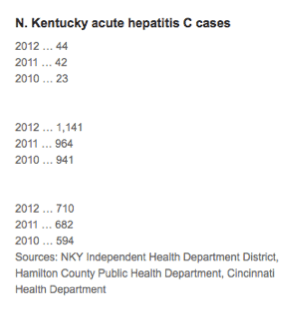| |
Hepatitis C cases climbing in NKY......Almost 88 percent (of those tested) had a history of IV drug use......Many of those tested have been in the age group of 20-29
|
| |
| |
......from transitional housing or treatment centers......baby boomers have been targeted .....we have been seeing it rise for a few years now......In Ohio, the Hamilton County and Cincinnati health departments have seen hepatitis C cases trend up in the last few years, as well, and encourage at-risk people to be tested........"We are not seeing a spike," said Rocky Merz, spokesman for the Cincinnati Health Department. "It continues to be a disease we are concerned about and has been for many years.
http://news.cincinnati.com
Jan 25, 2013
EDGEWOOD - Hepatitis C is plaguing Northern Kentucky, where the rate of people infected is far higher than the state or national rate, and the region's heroin epidemic is cited as the likely cause.
The virus attacks the liver, and chronic cases can result in liver damage, liver failure, liver cancer or death.
The Northern Kentucky health department is fighting back by providing testing and information about the blood-borne disease, with the state and the Centers for Disease Control and Prevention keeping an eye on the region.
Northern Kentucky's rate of hepatitis C was three times the state's in 2011 and about 10 times above that of the United States when compared to the CDC's 2010 rates. National data is not yet available for 2011.
The Independent Health Department District is taking part in a pilot program, offering free testing for anyone concerned and targeting high-risk groups.
Those who test positive for the disease are provided with counseling, education and direction in how best to get care.
Health officials hope they will gain a better understanding of the extent of the problem in Northern Kentucky through the testing, said Emily Gresham Wherle, spokeswoman for the NKY health department.
Their findings might translate into more CDC funding for the tests and help the state get certified to do regular testing for hepatitis C for local health departments, Gresham Wherle said.
Twenty-three cases of acute hepatitis C were reported in Northern Kentucky in 2010, but the number increased to 42 in 2011, according to health department records.
The first round of free testing began in May of 2012. In September, the CDC extended the program, and by the year's end, the health department had tallied 44 cases of acute hepatitis C, officials said.
Counties included in the NKY health district are Boone, Campbell, Kenton and Grant. Testing will continue at least until March, when the CDC will evaluate results, said Jennifer Hunter, the health department's director of clinical services. The program could be extended again if the CDC sees fit, she said.
Hepatitis C is most commonly transferred by sharing needles, syringes or other equipment used to inject drugs.
"Almost 88 percent (of those tested) had a history of IV drug use," Hunter said.
Health officials believe that the heroin problem in Northern Kentucky is fueling the hepatitis C problem because users often share needles.
The current high rate of new hepatitis C cases can be partially attributed to the health department's effort to identify and test high-risk people, said Dr. Lynne Saddler, district director of health.
Many of those tested have been in the age group of 20-29, Hunter said, and many have come from transitional housing or treatment centers. Additionally, baby boomers have been targeted because public health departments advise that they get tested.
"We are no longer surprised by the numbers because we have been seeing it rise for a few years now, said Patricia Burns, infection control coordinator for St. Elizabeth Healthcare hospitals.
"I have to think it is related to the issues in NKY surrounding illegal, intravenous drug use."
Hepatitis C also can be contracted through needles used for tattooing, but Saddler said the licensed tattoo shops in Northern Kentucky are not a threat.
There is no vaccine for the disease, but health officials encourage testing to ensure those afflicted are treated by a physician and to prevent new cases.
"Obviously, these folks need to know what their status is and take appropriate actions in their own lives," Saddler said. "We all need to be sure we are reducing our risks."
The acute hepatitis C virus infection is a short-term illness that occurs within the first six months after someone is exposed to the virus, according to the CDC. Most acute cases lead to chronic hepatitis C.
In Ohio, the Hamilton County and Cincinnati health departments have seen hepatitis C cases trend up in the last few years, as well, and encourage at-risk people to be tested.
"We are not seeing a spike," said Rocky Merz, spokesman for the Cincinnati Health Department. "It continues to be a disease we are concerned about and has been for many years."
Those who suffer from hepatitis C can be asymptomatic, but they need to get a physician's care, health officials said.
"Absolutely they should be under medical care," Burns said. "There are potential long-term consequences associated with ongoing hepatitis C infection, so the goal is to eliminate the active virus as soon as possible."
While some people do not improve with medicine, others do, and Burns noted, "New treatments are being developed and tried every day."

|
|
| |
| |
|
|
|